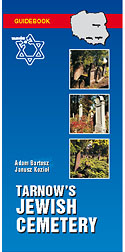
< wróć do wykazu publikacji
 | Adam Bartosz, Janusz KoziołTarnow's Jewish CemeteryGuidebookwydanie: I rok wydania: Tarnów 2007 wydawca: Komitet Opieki nad zabytkami Kultury Żydowskiej Muzeum Okręgowe w Tarnowie ISBN: 978-83-85988-66-3 objętość: 48 str. format: 100 x 210 mm opis: Tarnow’s Jewish cemetery, called ‘kirchol’ by the locals, is one of the biggest and most interesting Jewish graveyards in Southern Poland. It is also one of the oldest, with great history and beautifully carved headstones. It covers over 3.20 ha (32,000 m2) surrounded by a brick wall and a metal fence from Sloneczna Street on the south. < The cemetery was devastated by the Germans during World War II and later by local hooligans for several years. In 1988 a Committee For The Protection Of Monuments Of Jewish Culture and its monuments was established in Tarnow. One of its major tasks is looking after the cemetery, which was over grown by a 40 year old forest, had no fence from the east and north and lots of headstones fallen down or destroyed. In the late 80s and early 90s many things happened: many trees and bushes were cut down, the old wall was repaired, some headstones were erected again and the funeral building was renovated. Now, the trees and greenery is looked after and a grave keeper’s job was established. Adam Bartosz .......................... The symbolism on the headstones in Tarnow’s Jewish Cemetery is also the history of the struggle of the artists as the bible forbade the depiction of iconic images (Deuteronomy 4:16-18; Exodus 20:4). Walking through the Jewish cemetery allows us to understand that the decoration of the headstones represents a change of Jewish thought. The oldest are the least decorated, then there are those with simple Hebrew texts and those from the 20th century are often made of marble with Hebrew, Polish or German inscriptions. We have the graves of orthodox Jews next to the graves of Jews who wished to assimilate in Tarnow’s cultural life. And we also have the graves of those who were involved in Zionism or political groups, such as Bund. The comparison of the symbolism on these headstones demonstrates the development of thought in Jewish Tarnow. There are four thousand headstones in differing states of repair in Tarnow’s cemetery. Of course, the most destroyed are the oldest that are made of sandstone. Unfortunately, the marble headstones were destroyed by the Nazis and after the war they became desirable for thieves. The symbolism on Jewish headstones has a strict relationship to the engraved text which you can only fully understand after reading the whole text. As Hebrew is a difficult language what follows are some explanations of some of the symbols you can see as you walk through the cemetery. This will help you understand the sex, character, position and profession of the dead person and also sometimes gives light to the circumstances of their life or their death. Janusz Kozioł dodatkowe informacje: oprawa broszurowa ze skrzydełkiem |



